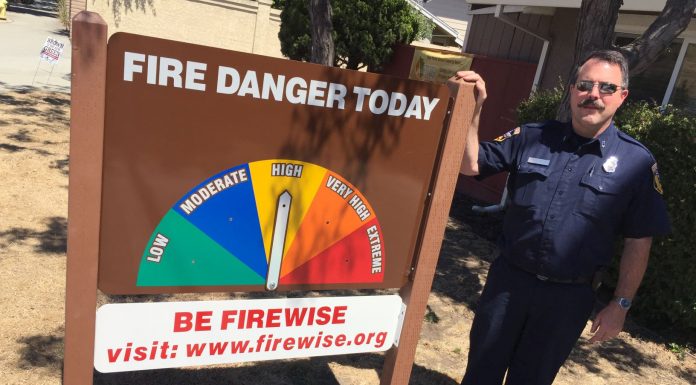Exploring All Public Safety Options Before Considering Taxes
I would like to clarify a number of quotes attributed to myself in your July 24 article on public safety.
Guest view: Protect your deck for fire safety
This guest view is part of a periodic series on tips to prepare for wildfire season, which started May 1 in Santa Clara County.Will your home survive when the embers arrive? Wind driven embers ignite many of the homes destroyed by wildfire. Your home could be at risk! BE EMBER AWARE and make changes to reduce the threat to your home. Remove leaves and pine needles from your rain gutters, keep your firewood a safe distance from your home and clean out debris from under your deck. You can learn more at emberaware.comMost people believe that wildfires ignite homes through direct contact with flames, but it is rare to have a home ignite this way. Flaming brands and embers can travel a mile or more ahead of the active front of a wildfire. Up to 60 percent of wildland/urban interface home ignitions result from embers.Tip Number 4: Deck dangerDecks are one of the parts of your home that are vulnerable to embers during wildfire. This applies to decks comprised of wood boards as well as those made from plastic and wood-plastic composite deck boards.If your deck ignites, the flames can ignite your combustible siding, break the glass on an adjacent window or sliding glass door, or climb to the eave and burn into your attic. If you have a deck and live in a high fire hazard area, you should consider the following:• Keep the gaps between deck boards free of pine needles, leaves and other debris. This tip also applies to the intersection between your deck and your house. Embers can become lodged in the gaps and ignite the deck. Also, don’t allow fallen pine needles and other dead plant material to accumulate on the deck surface during fire season.• The area underneath the deck is particularly susceptible to ember attack. Don’t store firewood, gas cans, lawn mowers, cardboard or other combustible materials under the deck and keep this area free of weeds, pine needles and leaves. Consider enclosing the deck with solid skirting, such as siding that is properly vented, or with 1/8-inch wire mesh to limit ember penetration and reduce maintenance. Don’t enclose it with wooden lattice.• Rotted or otherwise poor condition wood is more easily ignited by embers than wood in good condition. Replace deteriorated wooden deck boards and posts with new ones.• Install metal flashing between the deck and the side of the house. Be sure the flashing is installed to allow proper drainage of water.• If wildfire is threatening, remove combustible materials from the deck, including newspapers and magazines, baskets, door mats, dried flower arrangements, and place them inside the house or garage. Propane tanks should be placed at a distance of 30 feet or more from the house.Decks can contribute to the wildfire threat to your home. Take steps now to reduce the deck danger.Fire Marshal Dwight Good serves the Morgan Hill Fire Department and South Santa Clara County Fire Protection District and the CalFire Santa Clara Unit. He has 24 years of fire service experience. He can be contacted at [email protected].
Flat taxes are working around the globe; America needs them
As we recently celebrated our independence, it's important to
Guest view: Why I Joined the Women’s March on Washington
On Jan. 21, 2017, I joined what are now estimated to be 800,000 other people at the Women’s March on Washington, D.C. (and an estimated four million fellow marchers around the U.S. and the globe). The results of the Presidential election sunk my hopes for this great country, and inspired personal fear as a woman, a person of Jewish descent, as well as for the many marginalized folks whose rights Donald Trump staked his campaign on overturning.I felt alternating bouts of rage and despair that we elected a president who is on record making abusive and derogatory statements about women, people of color and the disabled, as well as bashing our venerated intelligence agencies, to name just a few. Not to mention he has no prior experience in any political office.At first, I was more nervous than excited—I feared reprisal from Trump supporters; I feared that in this frustrated and angry time, a tightly-wound lone shooter might express his dissent in bullets.Fortunately, that was not the case. If the counter-protesters were there, I never saw them. I was packed densely into the center of the National Mall, near Independence and Fourth Streets, with a direct view of the nation’s Capitol. My friend and I arrived by 8 a.m. Saturday morning, and by 8:30, you could no longer see streets in any direction—just bodies upon bodies carrying clever signs announcing their fears and concerns, many bedecked in the now-iconic pink hats.For five hours I stood and listened to fierce, passionate, committed speakers and artists plead for the rights of women, the disabled, the LGBTQ community, and against a Muslim registry and a wall at the Mexican border. Speakers included Gloria Steinem, Angela Davis, Michael Moore, Ashley Judd, Alicia Keys, Van Jones, California Sen. Kamala Davis, D.C. Mayor Muriel Brown, the mothers of slain black children and so many more activists, politicians and entertainers.Despite this enormous outpouring of energy and effort around the country, people are criticizing the movement. What did you want to say? What purpose did it have? Why can’t you all just shut up and accept things as they are?Last I checked, this country is still a democracy, albeit one that’s under threat. The Trump administration has already made clear it is hostile to media criticism. It has made steps to defund women’s health and climate science, and to repeal healthcare. Protest and demonstration are our Constitutional rights and one of the many ways we can create change.Change comes when we the people put pressure on our leaders to let them know what matters to us. As President Trump’s loss of the popular vote by nearly three million votes reveals, he doesn’t speak for many of us.The Women’s March was a fierce rallying cry as we launch into the beginning of many battles: for women’s bodily autonomy, for civil rights, for a decent world where we take care of our own and stay in good stead with the rest of the world.I’ll be bringing the same fierce energy to my own community in the days to come.Jordan Rosenfeld is a local freelance writer and author of seven books. She can be contacted at [email protected].
Gleefully Reminiscing About Paradise Points
Not long ago, on an absolutely warm and beautiful day, my wife, Joanne, and I journeyed to San Juan Bautista to visit La Casa Rosa. We have loved this restaurant for, at least, 20 years. They serve only three entrees: Old California, New California, or Chicken. (I am not going to explain. You have to find out.)
Board of Supervisors should abandon minimum wage proposal
In May, Supervisor Dave Cortese proposed raising minimum wage to $10 per hour in unincorporated areas of the county. Gov. Brown has since signed legislation to increase California’s minimum wage to $9 per hour on July 1, 2014 and to $10 per hour on Jan. 1, 2016.
Guest view: Enjoy Independence Day in Morgan Hill
Happy Fourth of July from Freedom Fest!Yes, it's that time of year again, time to celebrate the birthday of our great nation. And, what better way to do so than to attend the events provided, free of charge, to our community, by Morgan Hill Freedom Fest.Begin on Monday by attending the 29th annual Patriotic Sing, 6 p.m., at the Morgan Hill Amphitheater, 17000 Monterey Road. Here, local children will be singing the songs of America and honoring our Armed Forces. Sing along as our children continue a tradition of performing patriotic songs on the eve of the Fourth of July! Please bring a lawn chair. Donations to our deployed troops will be accepted. (Check out southbaybluestarmoms.org for a list of soldiers' requests.)For those of you who are fans of Angeline Madriaga, she will be singing at this event as well as at the Family Music Fest in downtown Morgan Hill. The Music Fest begins immediately after the Sing, and features food, music and fun for all.On Tuesday, July 4, our events begin early (register at 6:30 a.m.) with the 1 Mile Children's Run and the 5K Adult Walk/Run. Then, find time to sit, at 9:30 a.m., and watch the Car Cruise along the parade route. At 10 a.m., you'll feel a sense of pride as our Freedom Fest Parade winds its way through Morgan Hill. Bands, horse units, community service groups and churches are represented in the entries.But wait, there's more! Our Freedom Fest events conclude at the Morgan Hill Outdoor Sports Center, 16500 Condit Road, with music and fireworks at dark. All in all, there are so many ways to make memories of a Hometown Fourth of July in Morgan Hill. Please see mhfreedomfest.com for complete details.Thank you to our Freedom Fest sponsors, to our members who work so passionately to present our events, and to all of you who will attend our celebration. We hope you are left with a renewed sense of patriotism and a new appreciation for Morgan Hill, this place we call home.Karen Ann Crane is the organizer of the annual July 3 Patriotic Sing, which is part of the Freedom Fest Independence Day festivities in Morgan Hill.
We Live in a World of Subtlety and Nuance
Fifty years ago, the film "12 Angry Men" had its premiere. Based on a play originally performed on television, "12 Angry Men" had an all-star cast. Henry Fonda, Lee J. Cobb, E. G. Marshall, Ed Begley, Jack Klugman, Jack Warden and Martin Balsam, among others. The film is about the 12 men, jury members deciding the fate of a young man from the tenements of New York accused of murdering his father.
Because I’m So Good, I’m Going to Give Back
We heard that Brad Pitt and Angelina Jolie intend to sell their baby's pictures for $4.1 million with money going to a children's institution.
City Hall not liable for injuries self-inflicted by former city attorney
Less than a year ago the Morgan Hill City Council agreed to






